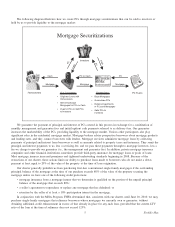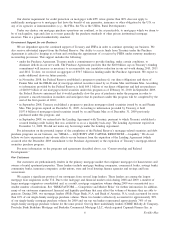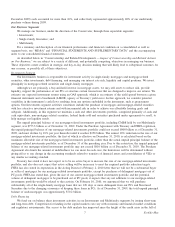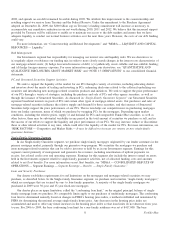Freddie Mac 2009 Annual Report Download - page 18
Download and view the complete annual report
Please find page 18 of the 2009 Freddie Mac annual report below. You can navigate through the pages in the report by either clicking on the pages listed below, or by using the keyword search tool below to find specific information within the annual report.
SIFMA publishes guidelines pertaining to the types of mortgages that are eligible for TBA trades. Mortgages eligible
for purchase by us due to the temporary increase to the conforming loan limits established by the Economic Stimulus Act of
2008 are not eligible for inclusion in TBA pools. However, SIFMA has permitted mortgages that are eligible for purchase by
us due to the increase to loan limits for certain high-cost areas under the Reform Act, which we refer to as “super-
conforming” mortgages, to constitute up to 10% of the original principal balance of TBA pools.
Credit Risk
Our Single-family Guarantee segment is responsible for pricing and managing credit risk related to single-family loans,
including single-family loans underlying our PCs. For more information regarding credit risk, see “MD&A — RISK
MANAGEMENT — Credit Risks” and “NOTE 7: MORTGAGE LOANS AND LOAN LOSS RESERVES” to our
consolidated financial statements.
Multifamily Segment
Through our Multifamily segment, we guarantee, securitize and invest in multifamily mortgages and CMBS. We also
securitize and guarantee the payment of principal and interest on multifamily mortgage-related securities and mortgages
underlying multifamily housing revenue bonds. The mortgage loans held in the Multifamily segment are secured by
properties with five or more residential rental units. These loans may have either adjustable or fixed interest rates, and some
may have an interest-only period that converts to amortizing at a future date. The loans are generally structured as balloon
mortgages with terms ranging from five to ten years and include provisions for the payment of yield maintenance fees to us
if the mortgage is paid prior to the end of its term. Our multifamily mortgage products, services and initiatives primarily
finance rental housing for low- and moderate-income families.
Prior to 2008, we purchased and held multifamily loans for investment purposes. In 2008, we began purchasing certain
multifamily mortgages and designating them as held-for-sale, as part of our expansion of multifamily security products. In
2009, we increased our securitization of multifamily loans through the issuance of Structured Transactions totaling
$2.4 billion in unpaid principal balance. We expect to continue purchasing multifamily loans and designating them as held-
for-sale as part of our further expansion of multifamily securitization transactions in 2010. We may also sell multifamily
loans from time to time.
The multifamily property market is affected by the relative affordability of single-family home prices, construction
cycles, and general economic factors, such as employment rates, all of which influence the supply and demand for
apartments and pricing for rentals. Our multifamily loan volume is largely sourced through established institutional channels
where we are generally providing post-construction financing to large apartment project operators with established track
records. Property location and rental cash flows provide support to capitalization values on multifamily properties, on which
investors base lending decisions.
The market for multifamily properties relies on having successful apartment developers and operators to develop,
administer and maintain the properties. Many such companies experienced significant financial difficulties in 2009 due to the
challenging market conditions. As a result, the ability of multifamily apartment developers and operators to continue to
support new property development and invest in existing properties is limited. This could result in lower capacity for industry
growth and reduced expenditures on improvements of existing properties.
Our Multifamily segment also includes certain investments in LIHTC partnerships formed for the purpose of providing
equity funding for affordable multifamily rental properties. In these investments, we provide equity contributions to
partnerships designed to sponsor the development and ongoing operations for low- and moderate-income multifamily
apartments and, we planned to realize a return on our investment through reductions in income tax expense that result from
federal income tax credits and the deductibility of operating losses generated by the partnerships. However, we are no longer
investing in these partnerships to support the low- and moderate-income rental markets, because we do not expect to be able
to use the underlying federal income tax credits or the operating losses generated from the partnerships as a reduction to our
taxable income because of our inability to generate sufficient taxable income. See “NOTE 5: VARIABLE INTEREST
ENTITIES” to our consolidated financial statements for additional information.
We also guarantee the payment of principal and interest on multifamily mortgage loans and securities that are originated
and held by state and municipal housing finance agencies to support tax-exempt and taxable multifamily housing revenue
bonds. By engaging in these activities, we provide liquidity to this sector of the mortgage market. See “MD&A — MHA
PROGRAM AND OTHER EFFORTS TO ASSIST THE U.S. HOUSING MARKET” for further information.
Our Competition
Historically, our principal competitors have been Fannie Mae, the FHLBs, Ginnie Mae and other financial institutions
that retain or securitize mortgages, such as commercial and investment banks, dealers, thrift institutions, and insurance
companies. Since 2008, most of our competitors, other than Fannie Mae, the FHLBs and Ginnie Mae, have ceased their
15 Freddie Mac
























